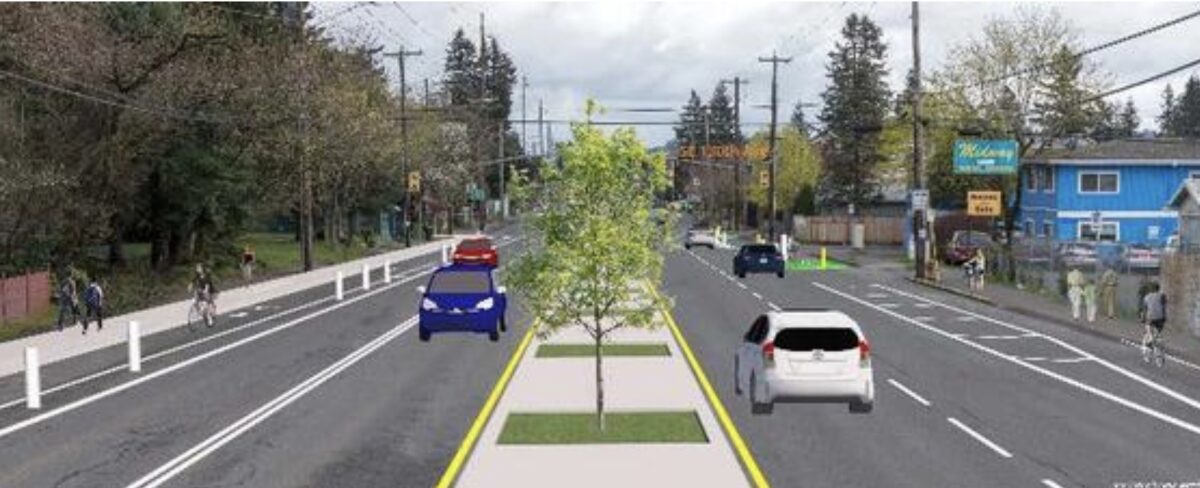
This opinion comes in the form of a letter to the Portland Bureau of Transportation from Kem Marks, Director of Transportation Equity for Rosewood Initiative. We’ve also published a response from PBOT Project Manager Steve Szigethy.

(Photo: J. Maus/BikePortland)
To whom it may concern,
We are writing to express our concerns with the survey PBOT is disseminating as part of its community outreach for the East Portland Arterial Streets Strategies project (EPASS). Although we are writing regarding the EPASS survey, we feel it is emblematic of most of the surveys conducted by PBOT. This letter is being written with the intent to change how this survey and future surveys by PBOT are written.
The survey in question has many problems. The language used to frame many of the questions creates false narratives, e.g. either/or situations that then create false choices in the answers. The potential answers create black and white alternatives, and do not allow for a more nuanced response. An example of this is:
This shouldn’t be an either/or response. First of all, this framing is based in a mentality of austerity. With the Fixing Our Streets program, HB 2017 revenue, and a potential transportation measure next year, we have more funding than ever. Given the City’s history of neglecting East Portland, the city should stop making East Portland bear the burden of inferior infrastructure so it can “spread the wealth”, especially to parts of Portland that have not been neglected. In fact, the city should go beyond parity with the rest of Portland to make up for the past intentional neglect.
PBOT must address its lingering autocentric biases that are replete in this survey.
Question #1, which is ostensibly about pedestrian crossings, has the following option, “PBOT should focus on pedestrian behavior such as crossing at crosswalks or carrying lights”. The question appears to be about placement of crossings, and thus this answer seems incongruent to the question. It creates an option that puts safety solely on the pedestrian, and smacks of victim blaming. PBOT has policies on crossing spacing as well as intersections; thus we have to ask, what would PBOT do with the results if this were the highest scoring answer? Along this line, would PBOT seriously not have mid-block crossings if that option were the top scoring or second scoring answer? Other than measuring anti-pedestrian sentiment, neither option seems legitimate.
We also wonder why respondents can only choose one answer instead of “all that apply” or using a ranking system. Question #3, Street Lighting, is a perfect example of where multiple answers are highly likely. A respondent could easily be concerned with safety from being assaulted, and be concerned about seeing the sidewalk and obstacles. They may also want more lighting on the street surface to see people or objects in the travel lane.
Given the fact that these surveys are an integral part of PBOT’s decision-making for project development, we strongly encourage PBOT to take this survey down and redo it so that respondents have true options that reflect people’s needs. We also encourage PBOT to develop better surveys, and to get input from community organizations, or alternatively hire consultants to train staff on how to write proper surveys.
In conclusion, PBOT must address its lingering autocentric biases that are replete in this survey. In addition, PBOT must use surveys that will elicit meaningful community feedback, which means using multiple languages, and other forms besides online. PBOT must also start treating East Portland with respect, by providing us with the same level of infrastructure as the rest of the city and follow its own standards.
Thank you for your time.
– Kem Marks
(PBOT response is below the jump.)
Advertisement
Response below is from PBOT Project Manager Steve Szigethy:
The survey uses a “forced choice” model. This method sometimes puts the respondent in a challenging position by forcing them to choose one option, when really they may like multiple options presented, or they may like none of them. This is intentional. It forces the respondent to make a choice that involves a trade-off, rather than being able to support doing everything, or expressing neutrality. In reality, most of these choices are not a zero sum game. For example, we are going to continue to add new enhanced pedestrian crossings while also seeking to improve the safety of existing signalized intersections. We are not going to pick one approach and abandon the other. However, seeing responses in the aggregate (with hundreds of people answering the survey) can help us see general preferences, trends, and public support (or lack thereof) for PBOT initiatives.
Regarding the purpose and intended use of the survey, it is advisory. It will be one source of many that helps us with decision making as well as how we communicate and roll out decisions. Our adopted policies and data-driven approach to safety interventions and investments remain critically important, and in almost all cases these policies and data will be the lead factors in making decisions. For example, we are not going to cancel all road reorganization projects if they are wholly unpopular in the survey. However, we also must recognize that public perception of city actions can play a big role in the success or failure of projects and initiatives, now and in the future.
Regarding the desire for more nuance, that is a challenge with most public surveys. When we were creating the survey, we began with a much longer survey that had about four times as many questions and that relied on choosing a level of agreement with statements (often referred to as a Likert scale). We ultimately decided that too many questions may result in fewer or incomplete responses, and that reliance on the Likert scale would not be as helpful as forced choices. We did, however, include the open-ended question as an opportunity for more nuanced feedback.
I’m sorry you’re not a fan of the survey but I do hope that you complete it, and that you share it across your networks. We’ve already received 450 responses, and we plan to continue advertising it across multiple networks, including intentional outreach to underrepresented populations.
Learn more about PBOT’s East Portland Arterial Streets Strategy here.
— Jonathan Maus: (503) 706-8804, @jonathan_maus on Twitter and jonathan@bikeportland.org
Never miss a story. Sign-up for the daily BP Headlines email.
BikePortland needs your support.


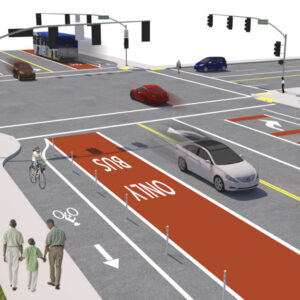
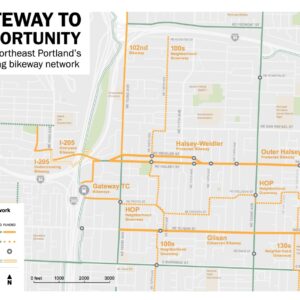
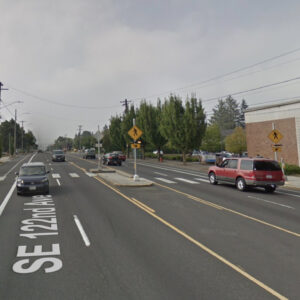
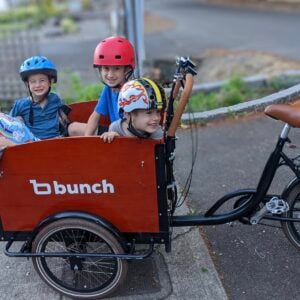
Thanks for reading.
BikePortland has served this community with independent community journalism since 2005. We rely on subscriptions from readers like you to survive. Your financial support is vital in keeping this valuable resource alive and well.
Please subscribe today to strengthen and expand our work.
This is the same pbot that says they aren’t in the business of closing pedestrian crossing even though they have closed several dozen in favor of cars. Let’s just remember that while.pbotnhas done some good things, they are still infected with car centric cultures and ideas. They aren’t the Portland bureaucracy of mutli modal, they are the bureaucracy of transportation. Which most residents believes means cars, trucks and SUVs.
PBOT must also proofread their surveys (“even if they narrower [sic]”)
Forcing people to answer austerity questions make it seem like we don’t have money. I would argue that we DO have money. Last week the Oregon Transport Commission reports from staff indicate that federal drop buckets ‘Travel Management Zones’ are not using even half of their local funding for actual local projects. Instead ODOT has been sweeping this funding into Freeway building. Forcing tax payers to ‘choose austerity’ when in fact austerity is being forced on us via poor management of existing local funds. How much Portland region federal funding for local projects actually went to build or maintain state freeways? That’s the real survey we want PBOT to undertake.
do you often conflate state and city organizations and use the errors of the first to criticize the latter?
Not impressed with PBOT’s response.
Kem 1:Steve 0
I thought the response was well explained.
I’m certainly no expert in survey design, but I can see the value in a forced choice model. Still, Steve Szigethy’s response doesn’t address some of the other, valid complaints. A choice such as “PBOT should focus on pedestrian behavior such as crossing at crosswalks or carrying lights” is absurd and may bias results. I suspect many respondents hadn’t thought of that as an option until PBOT implicitly suggested it, even if it isn’t being seriously considered.
I agree with you. From my experience with PBOT and other public agencies, the survey was likely put together from several sources within PBOT. Steve was likely responding to his portion, expecting that other staff would (eventually, maybe) respond about their portions of the survey.
Hold on now, if they had said “driver behavior” would that indicate a bias as well?
Let’s not project out our biases and emotional values into something created by someone else and maybe just read it literally.
IF one of the options had ALSO been “Increased enforcement against drivers who disregard crosswalks and speed limits,” that would’ve removed some of the bias (note, not all of it since still only one is blaming the victims). But it wasn’t. So what was your point again?
That we will project what we want to see and hear into what other people say, when what they are saying isn’t anything close to what you are hearing.
However, this survey was not about increased enforcement against drivers (which I support). Just because YOU want to see that does not mean there was a bias – it just means you were not asked questions about what YOU think are important.
If I went to a barbeque and they did not provide vegan options are they biased against vegans or is it simply a meaty event?
That would depend on what’s being offered and how they felt about it. If it was tofurky and Kosher pulled pork, how did the tofu and blessed pig feel about it? I have a bias against cars – they occupy a lot of space and I never learned to drive them, but I admit I’ve probably hurt their feelings on occasion. But drivers are often OK, some of my best friends are drivers, some even drive cars, and they usually admit they drive over the speed limit.
If you take the full survey you’ll see that there is a survey question specifically about increasing enforcement.
Why would PBOT ask about enforcement? They have no control over enforcement; that’s the Police Bureau.
PBOT works with the PPB on enforcement of driver compliance at pedestrian crosswalks.
https://www.portlandoregon.gov/transportation/article/594880
PBOT also installs the red light cameras and speed cameras, as well as designs lanes, intersections, and other infrastructure which if designed in certain ways can help with enforcement.
We have to project our bias because they failed to take it into account. It’s a transportation survey so they need to think about the typical attitude of every type of user and how they will see the question and answers. Then they need to keep redesigning them until they get something that’s not bias from any group. This is pretty typical messaging and they should know better.
A simple prefatory clause to the effect of “If you had to choose only one…” along with a footnote to the effect of “Note that we’ll probably do more than one…” would’ve eliminated this little back-and-forth.